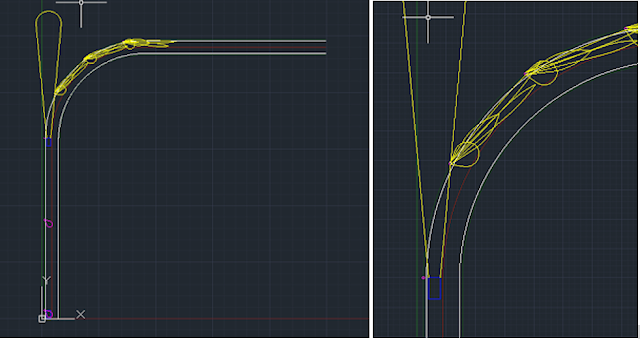Problem: road turns are dangerous at night time, especially mounting / forest region, rainy/foggy weather. Only a few luxury car models could turn head-light; with an average lifetime of a car about 20 years, external light on such turns is vital (plus wildlife statistics). Remote areas are too far/expensive to wire per car user there.
 |
| Road map: blue - car, yellow car and alert led lights, purple PIR detectors |
Solution: a set of 3-6 roadside reflectors with active light initiation and battery pack. Front 1-2 poles collect speed movement, simple processor turn on light on the rest 2-4 poles accordingly on short time (15-25 sec). Light could be gradual (by diode number) to inform opposite traffic and provide at least some light on smooth turns / save batteries.
 |
| ALeRT light pole (grey-ground section, pink interconnection, white - pole, yellow - cap) |
Description. 4 main parts: underground metallic (where batteries and electronics could be safely located); interconnection (holes for ventilation and create punch line stay or brake, and to easily compensate ground movement with a bend compensation), pole with 4 narrow gaps to direct led light, rotated cap with vent holes and reflector adjustable to road curve.
Cap, rotated to adjust road angle, has perforation for led ventilations. The reflector could be longer.
Set of led-laser (could be one). The gap with plastic-lense to direct light down.
The detector at the bottom (PIR passive infrared, or sonar or another cheap speed movement) will be on the first one-two poles (here shown as a universal pole).
Connection: gear-like rotational positions, perforations for air and breakpoint, clamps for easy set-up. L or semi-L shape connection to if ground changed buried part angle)
Batteries and electronics could be held in a sealed ground pipe (in case top part will be destroyed). Batteries could be located in a separate tank for quick replacement.
Separate quick replacement battery packs and solar units could be added. With LoRa range 15-20 km (take 10) some speed, battery statistics could be also in demand (or downloaded with recharge operation) (Long Range Wifi).
Risks and general obstacles:
Pole lean – danger to blind opposite traffic. Here why 3d printing with rapid prototyping could be helpful. The design has punched line at the bottom to prevent lean position. That part could be also exchanged to one with an angle to compensate ground movement. The main idea is to create the very cheap system (low traffic = low budget), hence low profile light with regular monitoring (recharging) could work out (proper poles with solar plus speed monitors also an option).
There are many ways to create such a system, hence no essential patent value / will be outpaced by low-cost countries. Initial design and testing could be still valuable to perform in local conditions: how much light (diodes = batteries/cost) is needed, how often to recharge (by whom), where road conditions are a life saver.
Cost is still essential. My preliminary calculations show > $ 10000 range, where batteries take 90% ( 3 months, 200 flashes per night). However, if 2 minutes service is acceptable (rangers, or local commuters: bird’s scooter scheme)…
Different road turns require different light patterns. Adjustable top part with light could be done, however, it could lead to worse (manual adjustment on road is costly, more small parts) than an available set of fixed common angles (10-20 types of tops to a range of turns) – again trial and error good test-filter.
Prehistory and other thoughts:
I was recently driving in Canberra national park and noticed there were more killed animals on road turns. It is truly dangerous on sharp turns: car lights straight making surroundings darker: quick reaction could lead to worst.
New laser-LEDs (2nd gen) are more efficient and batteries are out of question will progress exponentially (pure current papers * time to market). Hence, we should opt out of our wired paradigm.
Sldlaser.com
You may argue we have BMW Cornering Lights (or future Audi Matrix LED dynamic light) or self-driving cars overall. But even E.Mask, for example, mentioned 25 years as car life expectancy so there will be still time-use if done cheaply.
I saw the AutoCAD competition promo and decided to use the prize-math-expectation to facilitate drawing study and make some better pictures than common doodles. (it is not pictures only, though, if I’ll be lucky to get the 3d printer, I’ll do all my best to test and further develop the idea - let it be my small public commitment ;). If there are more worthy projects, the rare reader - feel free to ask for dwg files: it is good enough to know one might help to save some creatures.
As a small AutoCAD feedback (AutoCAD 2019 mechanical, trial): although I used AutoCAD in uni 15 years ago, it was harder to mind the gap than I planned. I stacked with default settings and was sure there should be Solidworks like drawing logic, but only a few buttons. Later I found some proper intermediate-advance tutorials, so all is fine (moreover, adaptive ribbons show there should be more stuff I don’t yet know like I briefly saw voice control). Possibly one-two dense quick extended feature video overview will be in demand. You may also create some mind map of features with 1min video-links. ( the smoother the learning curve, the faster feature-library search for rare functions the better adoption and product expansion). Thanks.




No comments:
Post a Comment